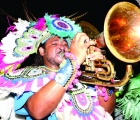Sea Turtle Life Cycle:
Sea turtles are long-lived marine reptiles that spend most of their lives at sea. They begin their lives as hatchlings just a few inches long, emerging from nests buried in sandy beaches. As they emerge they head for the ocean and spend several years being transported by the ocean’s current before settling back into coastal habitats. Sexual maturity varies among sea turtle species but ranges between approximately 15 and 50 years. Once sea turtles reach sexual maturity, males and females will leave coastal areas and migrate, often thousands of miles, to breeding areas where they will mate and begin their adult reproductive stage. Only females come ashore to lay eggs, usually near the area where they hatched perhaps two or more decades earlier. Females lay multiple clutches of eggs over the course of a couple of months. It is estimated that only 1 in 1,000 hatchlings will survive to adulthood.
Species of sea turtles most commonly found in the Bahamas:

(Left) A green sea turtle, commonly found in The Bahamas. (Center) Hawksbill sea turtle. (Right) Leatherback sea turtle.
Sea turtles come in many different sizes, shapes and colors. The olive ridley is usually less than 100 pounds, while the leatherback typically ranges from 650 to 1,300 pounds! The upper shell, or carapace, of each sea turtle species ranges in length, color, shape and arrangement of scales. Sea turtle mouths and jaws are also shaped differently depending on their particular diet.
Green turtles are found in shallow seagrass pastures and tidal mangrove creeks with their diet consisting of mainly sea grass. They have a beak with finely serrated edges, like the teeth of a saw, which enable them to tear seagrasses and scrape algae off of hard surfaces.
Hawksbill turtles are most common in coral reef ecosystems and feed on sponges with their beak-like mouth.
Loggerhead turtles are found in shallow coastal environments consuming benthic invertebrates. Loggerheads have strong, massive jaws which enable them to crush hard-shelled prey like crabs and whelks.
Leatherback turtles are pelagic turtles found in the open ocean and eat jellyfish. Leatherbacks have sharp, pointed cusps on their jaws which enable them to pierce and hold onto jellyfish. They also have sharp, downward curving spines called papillae in their mouth and throat which help move prey to their stomach.
Sea turtles are protected:
Effective September 1, new laws in The Bahamas completely prohibit the harvesting, possession, purchase and sale of sea turtles and their eggs found either within Bahamian waters or on any of its hundreds of beaches.
Why? Sea turtles have survived for millions of years but recently their populations have suffered due to human-induced threats that could lead to their eventual extinction. Traditionally harvested by fishermen for their rich meat, sea turtles provided a valuable source of income to fishermen, and an important food source to island people the world over. However, overexploitation and habitat loss has caused all four species found in the Bahamas to be recognized as endangered or critically endangered, and subsequently listed on the International Union for the Conservation of Nature (IUCN) Red List. In response to these severe declines in population numbers, the Bahamas Ministry of Agriculture and Marine Resources passed legislation that gave full protection to all sea turtles found in Bahamian waters in 2009. It is now illegal to harvest, buy or sell any marine turtle products, yet sea turtles are still in danger of losing important nesting grounds and foraging habitats due to coastal development.
What other threats are sea turtles facing?
Threats that they are facing include: overfishing, marine pollution that results in ingestion and entanglement, disease, habitat destruction, climate change.

(Left) A sea turtle caught in an oil slick. (Right) A sea turtle caught in a gill net.
What are we doing at CEI?
The sea turtle research program at CEI is studying juvenile turtles in their developmental feeding grounds. We have been tagging turtles across South Eleuthera and tracking their growth rates as well as population numbers. To learn more please contact info@ceibahamas.org.

(Left) A tag on a sea turtle flipper. (Right) A sea turtle eating plastic garbage.





